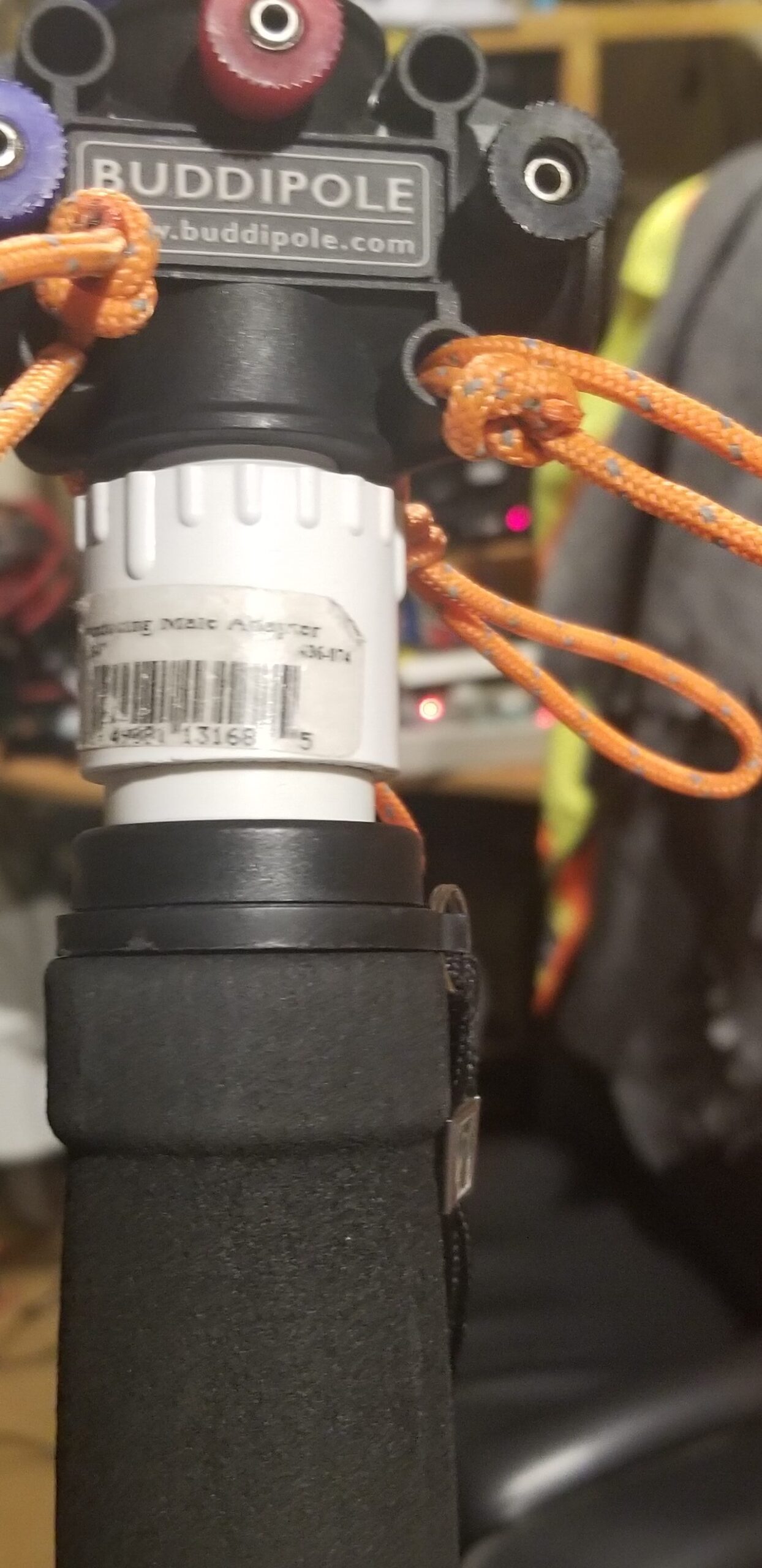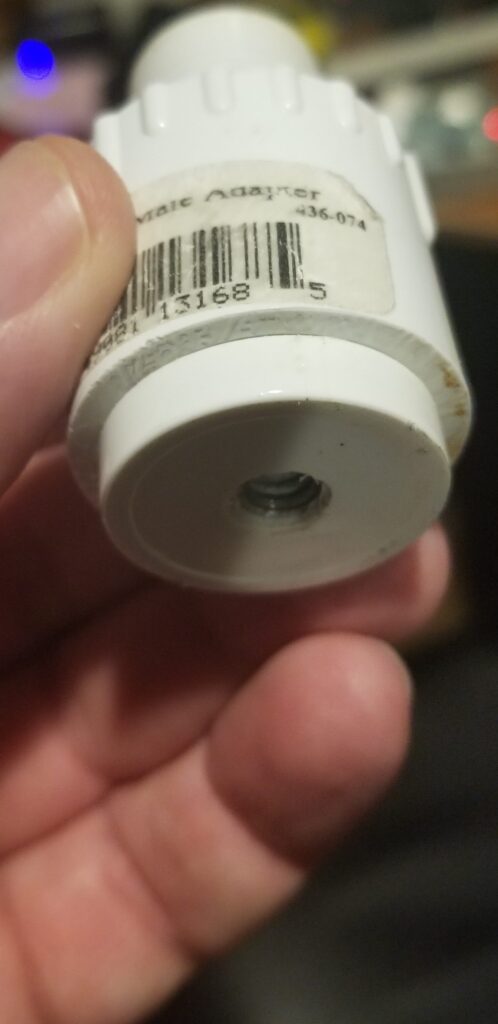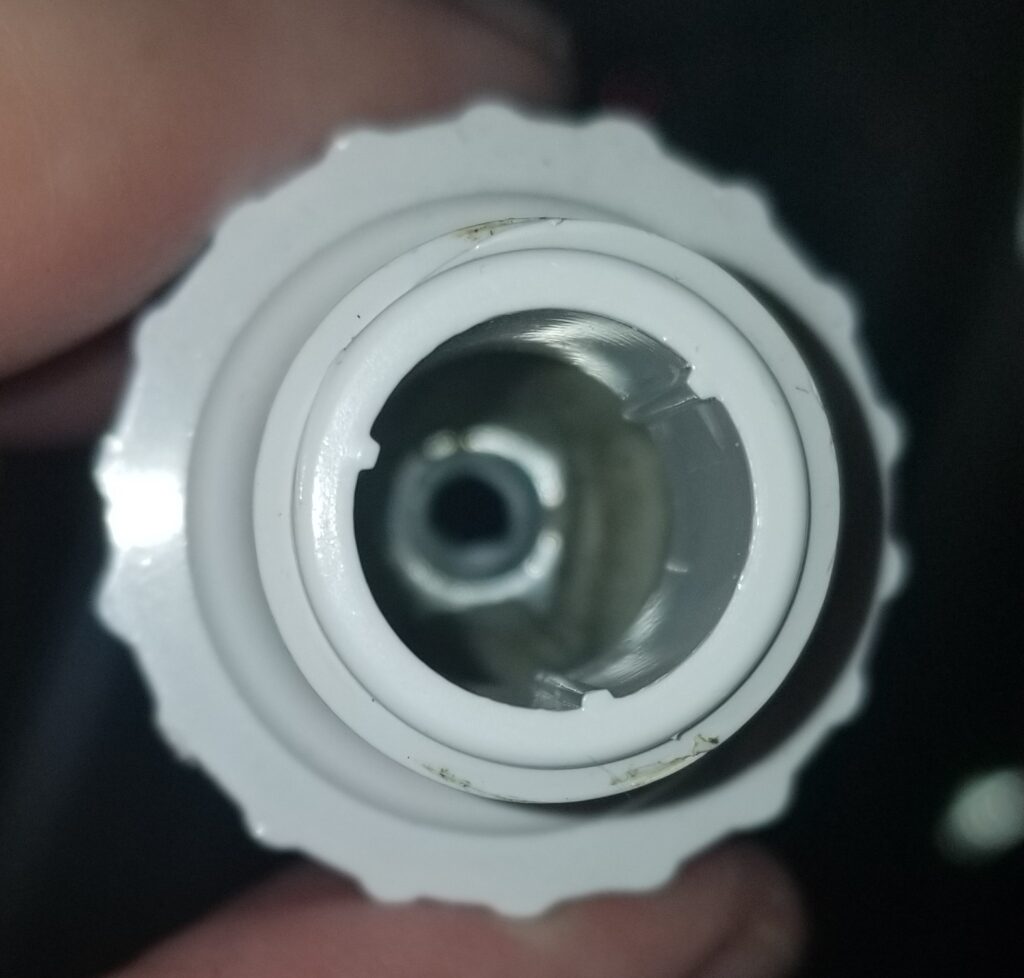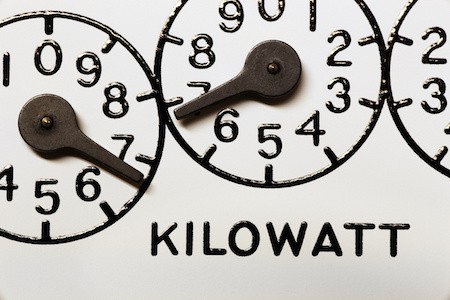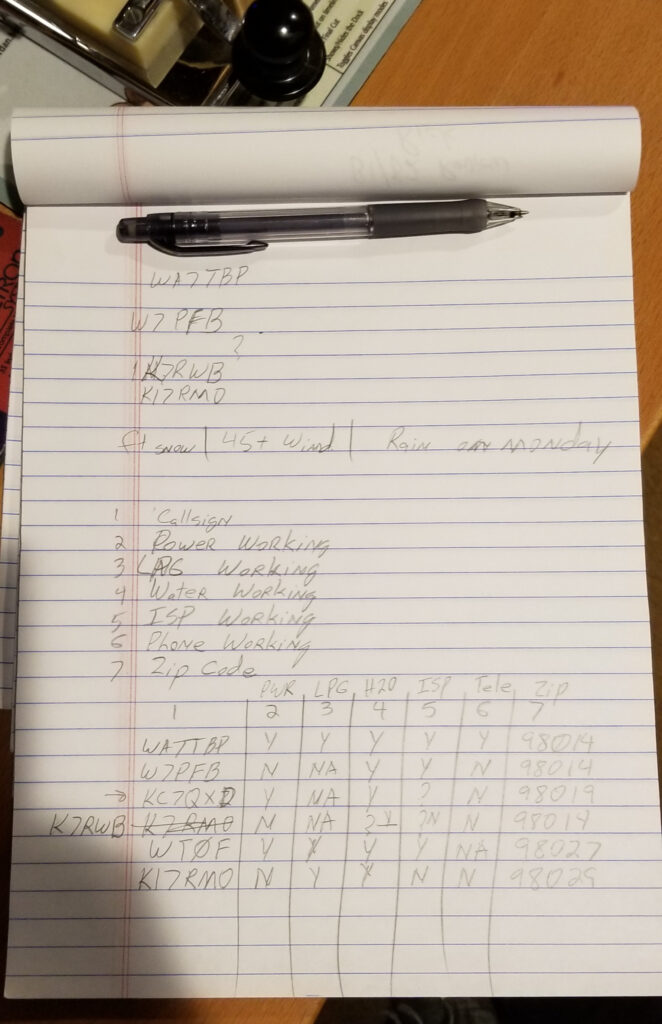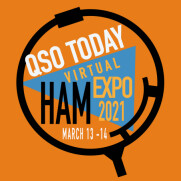One of the minor projects that I have been working on for a while now is to produce a Winlink form template for the weekly Winlink net. I have the first version of the forms completed and they are ready for download. You can find a description of what Winlink forms are and the download link here.
Tripod/Monopod Adapter
As hams we are by nature cheap. Partly because our hobby can be pretty expensive with all the radios, antennas and cables that we buy and partly because most hams are pretty industrious. We just don’t see the need to spend premo dollars on things that we can make ourselves for just a couple of bucks.
Just recently there was an email message going across a mailing list looking for a non-conductive tripod adapter for mounting an antenna. In this case I believe the ham was looking to mount a ham stick.
The mailing list did not allow image attachments through the list, so I figured I would throw a quick post together for the ham to get a couple of ideas and share with anyone else that might find some thing like this useful.
In my case I use a monopod and mount a Buddi-pole whip to it for a quick antenna that is wonderful for SOTA. The Buddi-pole whip actually mounts to a Versa-tee and the Versa-tee mounts to the adapter that I made, but the principle is the same.
I use a 3/4 inch PVC plug that can be found in pretty much any plumbing section of your local hardware store and drill a hole in the center to mount a 1/4-20 T-nut for attaching to the monopole. The T-nuts have “fingers” on them that get driven into the PVC plug to secure it. I also secure the T-nut inside the plug with a ring of JB weld epoxy mashed into the bottom of the plug. Make sure you leave the center empty so that if you have long threads they can continue up into the adapter.
For my adapter, I found that the Versa-tee had the same threads as some common plumbing threads. So I was lucky with just being able to find an adapter to glue the plug into.
If you are looking to mount a ham stick or other antenna that has a 3/8 inch mount (3/8-24 is the size bolt you will want to use), then it as as easy as another 3/4 inch plug drill a hole for a bolt. I would probably take the same approach of inserting the bolt in the hole and then take a bunch of JB weld epoxy and mash it into the end of the plug to secure the bolt. Then one does not need to worry about a nut to secure the bolt or having it loosen up and the bolt falling into the adapter.
Now just a short section of 3/4 inch PVC tubing (about 1 -1.25 inches) and some PVC cement will finish off the adapter. For about $5 or so you can have your own adapter which if it gets lost you don’t have to fork over another $20-$30 for another custom adapter. It is even easy enough to build in the field with a few basic tools if you need to.
73
Keeping a Station Notebook
Recently, this past weekend in fact, I came to the realization that I wish I had been keeping a better station notebook. You don’t hear a lot about this and occasionally one of the Youtube bunch will mention that everyone should keep a station notebook.
I do have a station notebook, but I don’t keep a lot of good notes in it (actually I don’t keep a lot of notes in it–good or bad). Mostly right now it has a list of the antennas mounted on the house and what function/band each antenna handles. It is not just one or two antennas on the house, but there are 7 currently and over the next couple of months there will be a few more added.
I have had too much cross talk on a few of the antennas so I have had to keep records of what frequencies are in use to know how that may affect other nearby antennas. So the notebook does assist me in coordinating where an antenna should be placed and limit the amount of interference experienced.
What triggered me this past weekend started several weeks ago when on a regular weekly net I was getting reports from other stations saying that my signal was pretty low and my audio was not as it normally is. From the reports it was as if I was nearing the range of the repeater with a good amount of noise on top of my signal. That might be acceptable if I were mobile and near the range of the repeater, but I was sitting at home. As far as I know there have not been any cataclysmic events that would have caused the house and the repeater to move several dozen miles away from one another. But who knows maybe I was sleeping late one morning….
I have since had the opportunity to pull the antenna down to inspect it and the coax. After reinstalling the antenna it has gotten slightly better but it does not seem to be back to the way it has traditionally performed. Probably just disconnecting the coax and reconnecting it helped a bit.
Anyway, I came to the realization that I need to perform monthly (at at least periodically) testing of all the antennas and record the results. As it is, I have not real data telling me how any of my antennas were performing when they were installed. So I have to rely on what many (most) hams do–their faulty memories.
To fix this from becoming an issue again, I am working toward keeping a historical record of the antenna analyzer measurements for each antenna in the station notebook. This way I can keep from getting in the situation where I have a sub-standard antenna when I need it in a deployment.
I am certain that there are many more things that should be getting included in the station notebook. I would love to hear from other hams as to what items are recorded in their station notebooks. So leave a comment below with suggestions of what other things should be included in a station notebook.
If you don’t have a station notebook, I challenge you to start one and work toward keeping your station operating at a higher level.
73
November Sweepstakes Weekend
This past weekend was the ARRL November Sweepstakes (phone) and it was a pretty good weekend the contest. I should have put more effort into the contest, but I did not do half bad. Below is the map of the sections that I made contact with.
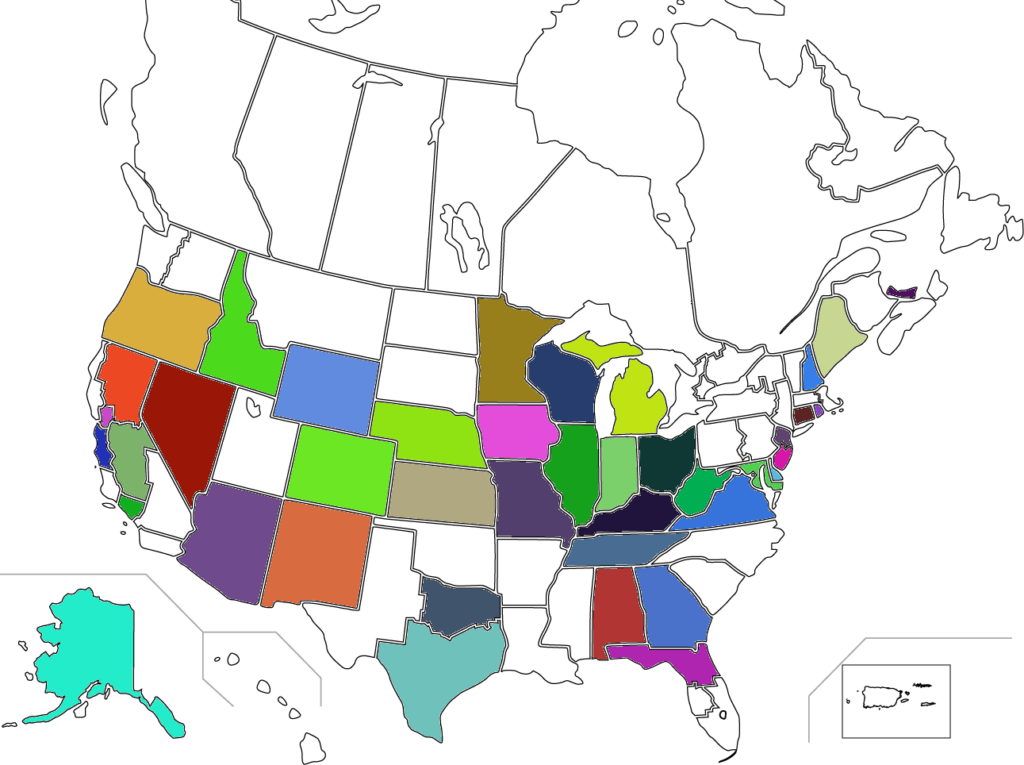
Certainly this does seem to be the best that I have ever done during the November Sweepstakes. I have not really kept track of my past contests that much. For the past year I have been archiving my contact logs for contests and I will make another posting that will detail what I do to archive my logs later.
The interesting thing that I took note of this past weekend was that I think this is the first time that I have ever made contact with Maine or New Hampshire. I even had a contact on Prince Edwards Island!
This was the first real contest (other than Field Day) on the EFHW-8010 antenna. So I don’t know if it is a matter of using the end fed antenna in a semi-inverted vee over my house or if it really is that the solar cycle is getting better. I suspect that it is the solar cycle.
I was not really expecting to have a clean sweep of the contest (contact all 84 ARRL sections), but I really think that I make more section contacts than any prior year. So I think that will be my goal for next year. By then hopefully the solar cycle is in full gear and I will be able to hit all the sections.
73.
Don’t use kilowatt for phonetics!
Just don’t do it. Stop adding to the confusion.
I hear this all the time and I am sure that you do to. Someone is checking into a net or you are in the middle of a contest and an operator spells his/her call sign phonetically. This in itself is not a problem (although there is a point in which I get irked with phonetic call signs but that will be left for another time). In fact, there are some really appropriate times to spell a call sign phonetically.
Myself, I always use the ITU phonetic alphabet. Most Hams know it (or at least most of it). OK, for those that are questioning what I am talking about it is the standard one you learned when you getting your license… you know “alpha”, “bravo”, “charlie”, “delta”….
A large number of Hams–disproportionally on HF–change out many of the phonetic words. Even if you are a new Ham you have probably heard some of these. The common ones are “america” for “alpha”, “radio” for “romeo”, “sugar” for “sierra”, “mexico” for “mike” and “zephram” for “zulu”. OK, the last one is not real I just had to keep all you Trekkies awake. For the uninitiated you can get educated here.
Am I wild about using alternative words for a phonetic alphabet? No, I can not say that I love the idea, but I do understand it. It allows fellow Hams to express themselves and add some creativity to their call signs. To me it does add a little bit of ambiguity to what is being transmitted to where it does cause most people to spend a couple hundred more milliseconds of brain compute power to translate the phonetic word back into a letter. Is that bad? No, it keeps people on their toes and thinking. Always a good thing. And we all have had that point where we are spelling a word phonetically and then the mind locks up on trying to remember the ITU phonetic word for a letter and it is just not coming. It happens and you find another word that you can substitute.
The one alternative phonetic word that should never, ever be used unless you are talking about a unit of power is “kilowatt”. I get worked up every time I hear some one use it. So much so I want to reach through the radio and slap the word out of the operator’s vocabulary.
Why should operators avoid this phonetic? It is very confusing. If you are net control for a net and you have a station check in as “kilowatt 7 alpha bravo” is the call sign K7AB or KW7AB? Being net control can be stressful enough, don’t make it harder for net control or any other station that you are working with. Just don’t use kilowatt as a phonetic.
I swear that if I continue to hear “kilowatt” used as a phonetic I am going to start to use “knife”, “pterodactyl”, “tsunami”, “pteria”, “gnu”, “czar”, “mnemonic”, “bdellium”, “hour”, “aisle”, “psoriasis” and “chthonic” as phonetics. If this does happen, then I will have been converted to one of those that just wants to watch the world burn.
73.
SnoVARC Mini-Exercise, Part 2
This is the second part of a post about the SnoVARC mini-exercise held on 24-FEB-2021. This time I will attempt to stay on the original topic that started the post.
In the previous post I went into a bunch of things that are generally good practices during EMCOMM nets. A bunch of good information and things that most operators don’t think about while sitting on a net or prepare for. So If you have not read the post yet, I encourage you to spend a minute or two and absorb it.
A quick review of the drill–explained much more completely in the previous post–the area has received an uncharacteristic large amount of snow and a net has been established to gather information and status from team members. There are seven items of interest (again refer back to the previous post for what they were) that each station needs to report and we want to do this in an efficient manner.
So lets think for a moment about how to organize and record information while the net is occurring. One needs a way to organize and quickly record information from the net reports.
To the right is a copy of the page I put together during the mini-exercise. It is slightly disorganized because it was being constructed as the mini-exercise was being laid out for us.
It is organized with the stations that check into the net followed by a quick summary of the scenario as portrayed by net control. Following that is an index of the 7 items that each station will report with. Finally a matrix of all the reports with a column for each of the 7 items. Organizing information in this way allows the reports to be collected much easier than writing out the reports in long hand.
The mini-exercise went well and afterward there is a bit of a hot-wash to discuss the experiences and learn from one another. It was a very good discussion and many good points were made by all involved. There was one topic that came up that was a little bit controversial for the group and it dealt with how to efficiently send the traffic to net control.
So let me start with how net control communicated how transfer the traffic. I also want to be very clear here that the following should not be construed that net control is/was wrong. Net control has to run the net the way that they are comfortable with and maintain control of the net. I am providing this contrast of sending traffic to allow net control stations and the greater EMCOMM community to think about what and where efficiencies can be made in moving traffic (BTW the National Traffic System has solved some of these problems decades ago and streamlined moving messages). There is one case where how net control requested and moved the traffic does make sense and that will be discussed toward the end of the post.
So here is now a typical message was sent during the mini-exercise:
NCS: WTØF, do you have commercial power? WTØF: Affirm NCS: Natural gas or propane? WTØF: Negative NCS: Running water? WTØF: Affirm NCS: Working internet? WTØF: Affirm NCS: Phone service? WTØF: November alpha (not-applicable) NCS: Zip code WTØF: 98027
A few notes about the above exchange. First there is a lot of back and forth going on. The mini-exercise was done over a repeater so there is a bit of turn around time between transmissions. On one of the exchanges net control and the reporting station where keying up so close to each others transmission that the courtesty tone was making the responses almost unintelligible. At best I was getting half of the response and trying to determine if it was a yes or a no.
Now consider if you have a station reporting in over an Allstar or Echolink connection. That turn around time on the repeater just got a lot longer. It is not impossible to transfer the traffic mind you, but both operators have to be a lot more disciplined to keep the flow going.
During the hot-wash, net control told of working a bike rally where this sort of protocol was used for moving traffic and it was a very fast transmission. One significant difference there being that the net for the bike rally was simplex rather than being on a repeater. So, yes, I can see some advantage when on a simplex frequency.
Another thing I want to point out is the terminology I used. Some of the participants stated in the hot-wash they did not like the affirm / negative terms vs. the yes / no that everyone else was using. Were they wrong? No, it is purely a preference or an opinion. But I would like you to consider a couple things as to why sometimes the affirm / negative terms are better. Yes / no are very short words and any noise or dropouts on the repeater can kill the response which means that there is more back and forth trying to get the correct response. Also, affirm / negative are very distinct words that are hard to mix up even with some noise or interference (in my opinion very necessary on EMCOMM HF communications). I should also note that affirm should not be pronounced as ‘ah-firm’ but ‘ay-firm’. The high A at the beginning makes it much more distinct even if the second half of the word gets wiped out.
So what am I suggesting for transferring the traffic? Consider the following exchange:
NCS: WTØF, please send your report WTØF: Power affirm, natural gas negative, water affirm, internet affirm, phone november-alpha, zip code 98027
Much more succinct and faster to transmit. Lets just say for the sake of argument that net control was not able copy (for whatever reason) the responses for water and phone service. How would the exchange look then?
NCS: WTØF, please send your report WTØF: Power affirm, natural gas negative, water ______, internet affirm, phone _________, zip code 98027 NCS: WTØF, please repeat water and phone WTØF: Water affirm, phone november-alpha
This also works if the reporting station does not come back with all the items in their initial report. Does this work for all situations? No, there are times when this would not work well.
But first, I want to tell you where this exchange came from. It was back in May 2020 when the Washington State EMD sent out some training for the ISNAP form (page 5). The ISNAP form has 39 boxes. The training for the form demonstrates the exchange with the back and forth just like the mini-exercise. That is a whole lot more back and forth. If you look at the form the top half is collecting information about the incident (that is 9 boxes). The bottom half of the form is a collection of 10 topics being collected that can be transmitted with less back and forth as shown above.
So I hope you can start to see that much of the time many exchanges can be much more efficiently transmitted and that will result in less operator fatigue and more throughput of messages. Especially in high stress situations.
Note: I was just referencing this post and re-reading a portion of it to send to a fellow ham and I had to make a comment or two on the paragraph above. When I wrote this post, I should have added these comments. I was a little glib with the last sentence and it has to be noted that in a high stress environment things will naturally go sideways and out of control. The way to combat increasing the chaos is to train a lot and get the operators to consistently do the same thing. This is part of what I was discussing in the first post of this series. Even with operators that are very knowledgeable with working within a net, a high stress situation will/can still cause things to go sideways, but it will be less likely and usually a much smaller disruption.
OK, so when does this not work well? There are primarily two cases. One is when the reports are coming in staggered or when the reporting stations have joined the net at different times and may not be on the same page with what items need to be reported on. This adds an additional dimension where net control may need to periodically announce the items to be reported on. If after reading the previous post about preparing for events in you area and you have done the work to prepare standardized status reports, then this should limit the amount of work that net control needs to do to inform stations what items to report on. This also means that your team needs to practice the reporting regularly so that know what needs to be done when an incident occurs.
The second case is when you have inexperience operators or operators that are not familiar with the status reporting that your team has in place. In this case net control pretty much has to lead the station through the reporting process like how it was done in the mini-exercise. One thing for your net control station to be vigilant about, especially with inexperienced operators, is that as they report each item there is a tendency for the operator to start giving more information or to start telling a story. Net control needs to be prepared to cut the operator off and instruct them to respond with the applicable responses.
Alright, there is a lot here to process. There was certain a few more things that came out of the mini-exercise hot-wash. This posting is already long enough I am not going to go into other items now. Many of these items keep coming up in a variety of exercises, so there is plenty of opportunity to discuss them in the future.
73.
SnoVARC Mini Exercise
This past Thursday evening the Snoqualmie Valley ARC (SnoVARC) held another one of their mini exercises. The mini exercises are held once a month on the third Thursday of the month and attempt to provide teaching opportunities for emergency communications.
With the snow that hit Seattle this past weekend–yours truly received 8.6″ of snow which is not as much as I used to receive in Maine, but if you have seen my driveway then you know this was not a trivial amount–the premise of the drill was to quickly and efficiently report ones current status to the net. In addition, WA7TBP wanted to add to the pressure by “throwing people under the bus” where everyone would need to track all the information and be ready to assume net control.
I especially like this last point as it is similar to things I have done on EMCOMM training nets. It is a wonderful thing mid-sentence during the middle of the net to just stop transmitting and see what happens. It clearly shows who is on the ball and who your best communicators are. But those are stories for another time.
So WA7TBP took a quick roll call to see who was participating and then gave a list of questions that each station needed to report in with. The information to report with was
- Callsign
- Do you have commercial power?
- Do you have natural gas/propane?
- Do you have commercial water?
- Do you have internet?
- Do you have phone service (twisted pair)?
- Zip code you are reporting from
Pretty straight forward and easy to report. There was about 5 of use participating in the exercise and everyone performed flawlessly. GREAT! We are all ready for Armageddon to arrive and can perfectly move traffic without introducing any errors! OK, I hope everyone can recognize that is pipe dream and things are never so simple in a real world scenario.
There are a couple of things I want to highlight from this mini exercise that I think can help a lot of other communicators.
First thing is to start planning now. No, I mean NOW. Stop reading this, grab some paper and start planning the mostly likely events that you may have in your area. OK, continue reading but put it on your calendar to have some drafts of a plan in the next couple of days.
Much of this planning comes in the form of what sort of events can be anticipated and what information is vital during the event that needs to be gathered or disseminated. Here in the Pacific Northwest we focus on floods, wind storms, earthquakes, and volcanoes. Although I hate to say it civil unrest is inching up the list (I am 15 miles or so from Seattle). Other areas need to focus on tornadoes, hurricanes, ice storms, heat waves and several more that I can not think of right now. So get your top 5 events, start putting a standard set of questions together for the status report and get that distributed to other members of your group. Having members of your group ready to go in an event is half the battle. Of course your group needs to practice the reporting structure periodically to keep everyone in a ready posture.
Another thing to think about is how to organize the information collected. You want something simple and quick to update. I am including a photo of the notes/log that I took during the exercise to give you some ideas how this can be done. You don’t want to have to be writing things out in long hand or digging around looking for that one form. You want something that can be constructed on the fly and readily marked up.
If this was a real event I would probably be working off of about 3 separate pages. One would be a log of who has checked in/out, times and other important traffic. Another page would be the consolidated page of reports. The final page would be a collection of notes concerning outstanding or significant reports (e.g. down trees, closed roads, injuries, collapsed buildings, etc.)
Another thing you want to establish is to have everyone tracking the same information. I say everyone but the reality is that there will probably be some people in the field that won’t have the capabilities to record and track the information. For those stations (usually fixed) that are on the net and are capable of logging the traffic, they need to do so. At any moment the net control station may go dark and another station may need to assume control. If the fixed station are not also tracking the information then it becomes a cluster you know what trying to regain control of the net and needing to gather all the information again. And by the way half the stations have gone away to handle other tasks and you can not gather their information.
Your group may want to collectively decide to have a hierarchy of stations that assume net control functions. Or the group may decide to leave it to the situation and who has the abilities to function as net control. Personally I like to ad hoc aspect the stations in the net electing/commandeering net control as it adds self-organization and self-repair aspects to the net. Neither way is right or wrong, but the group needs to practice it and feel free to experiment with them to find what works and what does not work. A lot of it depends upon the operators and their capabilities.
Well, I have gotten off the topic I really wanted to hit and this post is getting a bit long, so I will continue the original topic in another post.
73.
QSO Today Ham Expo
Not sure how I missed this, but the registration for the QSO Today Ham Expo is now open. Early registration opened on January 4th. Last year the event was free to all those that registered, but given the cost of putting on the event the early registration has been set at $10 for the two day event. Really still quite a bargain given the amount of information that you can walk away with.
This year the presentations will be held March 13th and 14th, 2021. While the schedule has not yet been set, a list of presentations can be found at https://www.qsotodayhamexpo.com/speakers.html. Lots of variety of topics listed there, so I am sure you will find several that you are really interested in.
So head over to the registration page now before you forget and miss out on the event.
73.
Net Schedules
Something I have been working on for quite a while now is a easy to manage list of Ham radio nets. Now I am ready to reveal to the world the work that I have been doing and allow people to start to consume it.
TLDR;
The nets are organized as a set of YAML files that describe each net. You can find the YAML files here: https://gitlab.com/wt0f/ham-radio-calendars. Each time a change is made to the files a new set of iCalendar files are generated. The iCalendar files can be subscribed to at https://nexus.wt0f.com/service/rest/repository/browse/calendars/.
More Details
I started thinking about the fact that there was not really a good catalog of nets or a way to stay up to date with the changes of nets. I liked what WA7BNM has done for contesting with making schedules available as a calendar file. That made sense to me given that one could have a list of nets but it gets hard trying to visualize when the nets occur or where there may be conflicting schedules. Hence I started building a catalog of nets.
Certainly this catalog is not complete. Even for the Seattle area, this is really just a subset of nets that occur. I have tried to include all the ones that I could find out about but I am sure that there are many more that occur that are not listed anywhere.
I have tried to organize the nets in a reasonable way that can be extended to support other areas and most situations. Although I expect that the structure of the files will change over time as others contribute to the effort.
Oh, yes, did I not mention that this is a cooperative effort? This is not just the nets that I want to track or publish–this allows anyone to contribute to the catalog of nets. This could be adding a new net (or one that is currently not listed) or updating information about a net that is not correct. This is accomplished by one of two methods. More on that in a bit.
Structuring the nets
I am not going to really talk about the YAML format for describing the nets here. You can find more information (which should stay pretty much up to date) at the GitLab repository that has all the files. Look at the README.md file for a pretty good description of the format. For those that are not familiar with the YAML format, it is a format that is easy for computers to process and equally easy for humans to digest. For an introduction to YAML look at https://www.redhat.com/sysadmin/yaml-beginners.
The net catalog is being organized into files that are broken down by counties and in some cases cities (for large cities–think Los Angeles, Dallas, Boston, etc.). These files are stored in a directory named after the ARRL section. So for example, the nets that occur in the city that I live in (Issaquah, WA) would be stored in WWA/king.yaml.
I think this provides a pretty reasonable compromise between the geographical location of the net and the grouping of the nets. In other words, there is not a huge file listing hundreds of nets which becomes cumbersome to manage and keep up to date. Conversely there is not a thousand little files that need to be kept up to date. In either of these extreme cases, it is not terribly difficult to duplicate information because the number of things to look at is just too large.
This scheme will cover North America pretty well. But what about other areas of the world? Well, I am not opposed to moving things around to extend where in the world the schedules represent. So without hardly any trouble at all, it would be pretty easy to add say a directory level for the continent and maybe a second directory level for the country. It is just not needed at this time, but it is easy to grow file structure to accommodate more schedules.
Now you may be asking what to do with nets that cover more than just a geographical region? These nets tend to be organizationally driven or using communications technologies that link over the internet (like DMR, Allstar or D-STAR). Right now I have been starting to organize these schedules in separate files and I figure that many of them will be in a directory at the top level called organizations. The idea here is that there would be a file for Allstar nets, American Redcross (national nets), NAQCC to name a few.
Again, this is subject to change in the future as the needs to organize the schedules becomes more complicated. But others will also have a say in how everything gets organized also.
Now It Is Your Turn
So how can you contribute? As I stated above there are two ways that anyone can contribute schedules or updates to existing schedules.
The first is to fork the repository (https://gitlab.com/wt0f/ham-radio-calendars) into your own GitLab account. If you don’t have a GitLab account, you can get one for free at https://gitlab.com/users/sign_up.
Once you have logged into your account you want to navigate to the repository. Then it is as simple as clicking the “Fork” button in the upper right corner of the repository page. Below is the top of the repository so you can see the Fork button.

This will create a copy of the repository in your GitLab account. With those familiar with Git, you are probably all set and don’t need anything else. If you have never touched Git or not even sure what it is, you can use the Web IDE that GitLab provides. In your copy of the repository you can click on the Web IDE button and this will allow you to make changes to the files.
Now that you have changes to the schedules, you want to commit the changes back to your local copy of the repository and create a merge request back to the original repository. The merge request then gets looked at and is either approved or provides a way to have a discussion about the changes so that all can agree that the changes should be made. Once approved that changes get applied to the original repository and a few minutes later the iCalendar files get updated.
The alternative way to get changes made and this is primarily for those that don’t quite understand how that darn YAML thing works. Visit the original repository and create an issue where the changes can be described. This will generally take longer as I need to collect the issues and then go make the appropriate changes in the repository.
I hope that many Hams out there will find this a valuable resource to keep track of nets and discover new ones. If you have any questions or comments, please feel free to hit me up.
73.
Good Info from HRU 2021
Today, January 9th, Ham Radio University is providing a number of presentations over GotoWebinar. This I think is the first time they are providing the presentations online and it is working well! Registration was free but $5 donations were suggested to support the costs of providing the GotoWebinar sessions. Personally I suggest doubling or tripling the donation to pay for some of the Hams that are unable to donate this year. Especially this year when so many have been unemployed.
I just sat through the HF Digital Modes presentation by Neil Goldstein (W2NDG) and there were a few good tidbits that came out of this presentation. His blog site looks like it has a lot of useful information also. You can find it at https://fofio.blogspot.com.
First a wealth of information can be found at https://www.g4ifb.com/. There is a bunch of information about running FT-8 there and I am still exploring a bunch of that information.
Another site to visit is https://midnightdesignsolutions.com/. They have a number of nice kits and I will leave it at that.
Next year when the HRU 2022 registration comes around, don’t hesitate and fill in the registration!
73.

